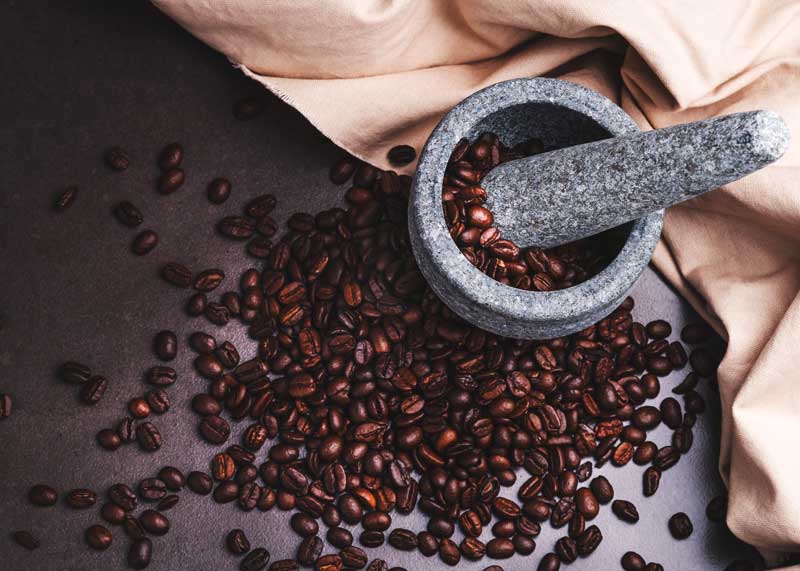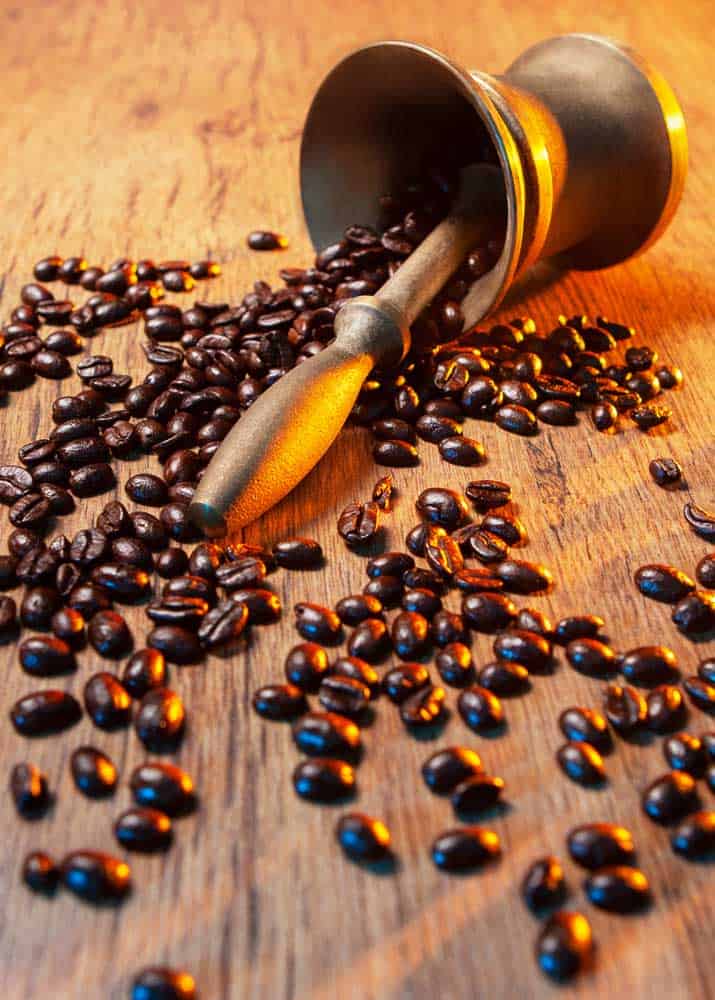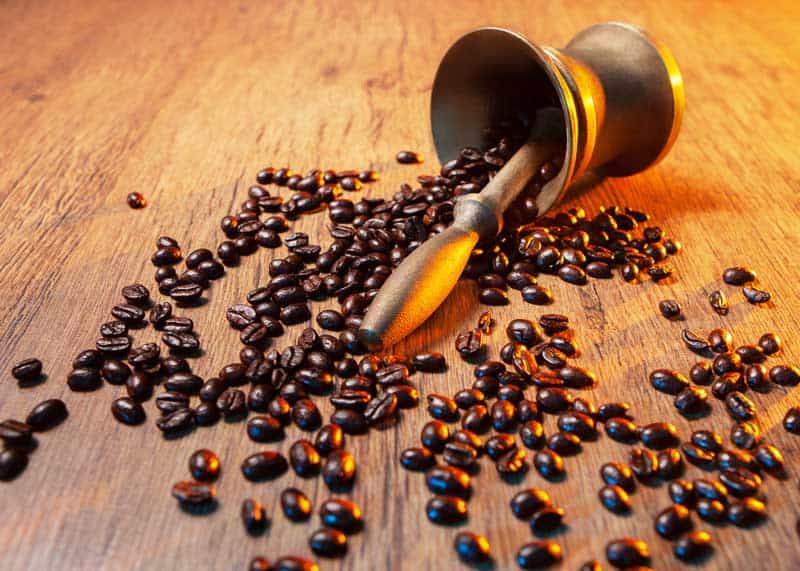What if you have coffee beans but no grinder? In this post, you’ll learn how to grind coffee beans without a grinder. These 7 methods will have you brewing coffee in no time.
The best methods for grinding coffee without a grinder are using:
- Mechanically: Blender, Food Processor, Magic Bullet, Spice Grinder
- Manually: Mortar And Pestle, Mallet, Rolling Pin
The two processes are chop and chip (high-speed mechanical) and crush (hammer, mortar, and pestle).

Fresh ground coffee beans make the best coffee. The grinding process makes the experience better. The fresh ground beans fill your home with the rich coffee aroma even before the brew begins.
But sometimes we accident buy whole coffee beans and don’t have a grinder at home. How do you grind coffee without a grinder?
If you find yourself with coffee beans and no coffee grinder, don’t worry. There are more than a couple of ways to grind whole roasted coffee beans into brewable ground coffee.
In this article, we will show you some of the simple coffee-grinding hacks for when you’re experiencing a coffee emergency.
What’s the best way to grind coffee beans without a grinder? The best way is with a mortar and pestle. It will make the best coffee and the least mess. It’s been in use for centuries and will be for centuries more.
Grinding Coffee Without a Grinder
Relax. If you’ve found yourself reading this article, it is likely because you’ve got beans and no grinder.
We’re here to help with some tried and true techniques for mashing up those aromatic beans. So worry not, you’ll still get your fix.
Grind Your Beans With a Blender: 5 Tips
Using your countertop blender isn’t going to get you the most uniform, nor the finest grind, but it will get you a usable product.
Here are a few things you should know before you start.
Use Short Pulses: Some blenders have a grind setting, and if not, they more than likely have a pulse setting. Once you’ve added the desired amount of coffee that you’d like to ground, and shut the lid, use short, controlled pulses to grind the beans.
- Don’t Cook The Beans: Why do we use pulses to grind the beans? Because grinding the coffee beans produces a lot of heat that can actually heat the beans even further. If you run it too fast for too long, it can actually burn the beans. That’s the last thing you need at this point. So, watch that heat.
- Don’t Overfill: When using a blender, it is important to grind only small batches at a time, like ¼ cup to ½ cup. Any more than that and you are increasing your risk of overheating your grounds. So, blend in batches if you need more grounds.
- Change Angles: This can be especially effective if you have an older blender that is a little weak when it comes to breaking down these hard, brown beans. Don’t be afraid to tilt your blender while you pulse so that the blades can attack the coffee beans from all angles. This allows for a more even consistent and better-finished product.
- Don’t Overgrind: Once all of the beans are broken down and you’re left with a sawdust-like consistency, you’re done. You are unlikely to get any finer texture than that. Though it might not be what you’re used to. It will work, trust us.
For grinding spices, and coffee beans in a pinch, I like the smoothie cups that come with a Ninja Blender. By pulsing the motor, it’s easy to crush and grind the beans to a decent grind.
Your grind is not going to be fine enough for espresso or Aeropress, but it will make a cup of coffee.
For a coarse grind, a French press will be your best bet. If you get a medium grind, an automatic or manual drip machine will do the job.
Grind Your Beans With a Magic Bullet: 4 Tips
Magic Bullet and Nutribullet blenders are very popular these days for those that like to start the day with a smoothie.
They also work fairly well for grinding coffee beans in a pinch. The Nutribullet Pro 900 can achieve a coarse grind as well as a decent fine grind.
Here are some things you should know:
Start Small: For the best product you are going to want to use the smaller cup that comes with the blender. This allows for a more consistent grind as the smaller space is easier to control. Aim to grind only ¼ to ½ cup at a time.
- Work In Pulses: Just like with the blender you should blend in quick, controlled pulses. This is a bit easier with the bullet style blenders as they only blend when you press down on the cup. Press and turn, release, repeat until you’ve achieved a desirable grind.
- Watch For Heat: Just like with the blender you want to watch for heat buildup. Too much and you’ll ruin your beans. So, while you can achieve a finer grind, don’t try too hard to get it perfect. Once it is mostly uniform, go ahead and brew a cup.
- Don’t Be Afraid To Tilt: Again, a little tilting can go a long way. You can even easily remove the cup with the blade-lid still attached and give it a good shake or tap on the counter to shift the contents.
This should net you a grind that is in the spectrum of medium to medium-fine.

Grind Coffee With Mortar & Pestle: 4 Tips
Now, we are passed the easy methods of grinding your coffee with household appliances. Now it’s time to get a little medieval with it. If you have a mortar and pestle, some patience and time, you’ll be drinking a coffee in no time.
Though this method is more labor-intensive and time-consuming you can actually break down your beans into nearly any consistency of grounds you choose, so long as you put in the work.
Don’t Overfill: Fill the mortar only ¼ to ⅓ of the way. Too much and you’re going to spill and have a more difficult time grinding. You’ll do smaller batches this way but it will be easier to control the consistency of your grind.
- Use Some Force, At First: Securely holding the mortar, use the pestle to smash the beans until you’ve broken down all the beans. Then you simply swirl the pestle, while giving some pressure, until you’ve smashed the bits into a desirable consistency.
- Grind and Grind Some More: Once you’ve achieved a coarse grind that is consistent enough to use, go for it. If you are using a percolator, a French press, or making a cold brew you can use coarse grounds. If not keep grinding until you get the desired fineness.
- Work In Batches: If you’re grinding finer and you need more, you’ll need to empty the mortar and start from scratch, adding the second batch to the first and so on until you’ve enough grounds of the same consistency for whatever brew method you are using.
If you don’t already own one, look for granite or similar hard material. You’ll want to avoid coatings and finishes that might come off while crushing your coffee beans.
Weight is also a factor – a heavy set is more likely to stay put while grinding the beans.
Mortar and pestles are a traditional and still remains a popular method for grinding coffee.
Here is a large wooden mortar and pestle from Cuba. They are inexpensive, don’t require electricity, and work for years without breaking down.

Though this method can take a lot longer than the previous two, you have a lot more control over the size of your grounds and you’re also without the risk of burning the beans. So, whatever grind you want is achievable so long as you put some elbow grease into it.
Here’s what it looks like:
Grind Coffee Beans With a Mallet or Rolling Pin: 3 Tips
For this, you’ll need a mallet or rolling pin and a ziplock bag. This method is so simple it is easy to overlook.
Though it is simple, it is time-consuming, so be prepared. You should aim for a coarse grind but you can go finer if you put in the time.
- Put Your Beans In A Bag: Gallon-sized freezer bags work best as they are thicker and you can add enough beans to use. But any sealable bag will work. Make sure to squeeze the air out before you get to work to avoid popping the bag.
- Smash Your Beans: Whether you’re using a mallet, or regular hammer, or rolling pin you want to use medium pressure. You’re not doing construction here, so only give enough pressure to break the beans.
- Repeat: Since you don’t have to worry about heat buildup, or overfilling, just pound or roll with medium pressure until you’ve achieved the grind you are looking for. With a hammer, you can get a bit finer, but your best bet is to aim for a medium-coarse grind and call that good.
On the other side of the spectrum, you might consider a coffee maker with built-in grinder. Here are our recommendations.

Coffee Roast Matters When Grinding
The darker the roast, the easier it will be to break, chip, and crush the bean.
A white roast bean is extremely hard. If you decide to try white coffee, you should buy it ground. Trying to grind them at home could damage your coffee grinder. Imagine how hard it will be to grind or smash with the other methods in this list.
To make it easiest on yourself, you should pick up a dark (or least medium) roast bean. Light roast will also be difficult to smash up without an actual coffee grinder.
Learn more about 5 levels of coffee roasts.
2 Dangerous and Difficult Ways to Grind Coffee
Here are a couple of ways that you could probably avoid when grinding your coffee beans.
- Knife: Some coffee blogs recommend using a knife to “squash” the bean, “the way you would a clove of garlic”. This is nonsense and I wonder if the writer has even seen a coffee bean in person. Garlic cloves have moisture content and have the physical ability to compress and break the cell walls. Roasted coffee beans are dense and don’t compress. The last thing anyone should do is press a sharp blade on a smooth, round, dense bean. You’ll either shoot the bean across the room or shred your fingers. Probably both. Please don’t do this.
- Meat Mincer: So this way will probably work. But you’ll need to have a clean mincer. So either have a brand new one – or one that has been fully sterilized since the last time it ground meat. Not only will meat residue affect flavor, it could also be dangerous. This method will be overkill and difficult to gauge grind coarseness. In a pinch, this will work. But not ideal.

Now, reward yourself with a cup using the French press or automatic. Aim for a coarse or medium grind. Any finer and you’ll be pounding and rolling for a long time.
Getting that cup of coffee is the main goal here, so we hope we’ve helped you to grind your beans and get a pot brewing. Where there’s a will, there’s always a way, especially when the reward is our daily dose of caffeine.
Have a tip or other method? Let me know in the comments!
- About the Author
- Latest Posts
Bryan Haines is a co-founder and writer on EnjoyJava – and is working to make it the best coffee blog in the world.
He is a travel blogger at Storyteller Travel and blogs about photography at Storyteller Tech. He is also co-founder of Storyteller Media, a company he started with his wife, Dena.
